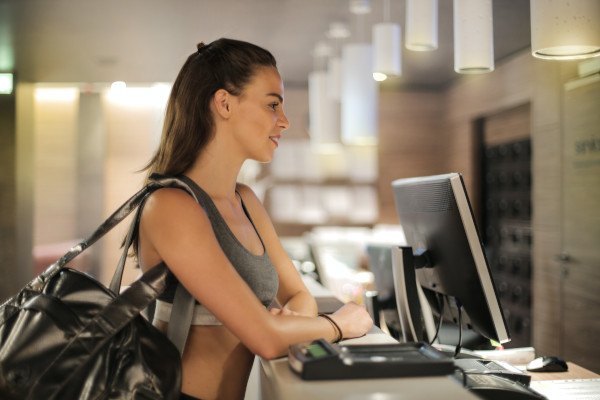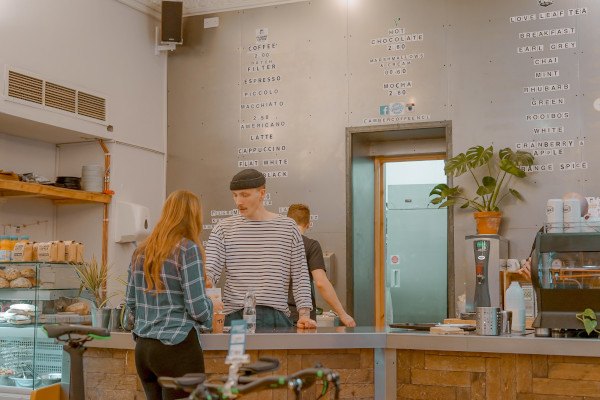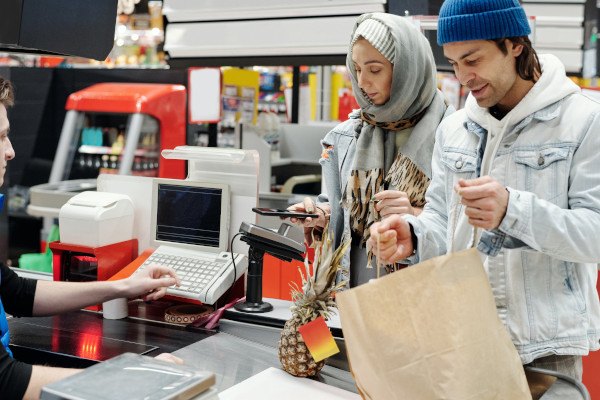Is Your Checkout Counter Driving Your Customers Away?
Did you know that nearly 64% of shoppers had walked out of a store because of its physical appearance or disorganization, and 86% of respondents tend to spend more time in neat stores? This is based on a study conducted by A Service Channel. The study found that 70% of 1,521 shopper respondents had a negative impression of a store because of their checkout experience.
Your shoppers’ initial point of contact with your employees and customer service representatives will be at the checkout counter. Therefore, how the counter is organized, decorated, and designed will significantly impact how consumers perceive your brand.
However, retail counters are often messy, especially in small businesses. It’s common to find printers, scanners, cash drawers, and monitors – all bundled together in an entanglement of cables, power supplies, and extension cords. This can create a negative impression on your shoppers.
Businesses should view their checkout counter as a way to express their creativity and identity through design and technology. The stores’ systems say a lot about its internal processes and dedication to customer service.
In this article, we are going to share with you some tips to declutter your checkout counters to improve your customers’ shopping experience in your small business.
What is A Checkout Counter?

The checkout counter is the point-of-sale (POS) of your retail store, where employees complete customer transactions. The most common types of checkout counters are:
Cash Wrap Counters
Cash wrap counters are areas where goods are exchanged for cash and wrapped up so customers can safely transport them home. Cash wrap counters include product displays, bulky hardware, kiosks, and advertisements. These areas are completely customizable, so your small business can create unique layouts and arrangements.
Cash Register Counters
Before, cash register counters were used to only store cash. However, modern digital models expedite various payment methods, including check and credit card processing. Many counters incorporate several hardware pieces, including cash drawers, monitors, and scanners.
3 Reasons To Start Decluttering Your Checkout Counter
Better Experiences
As the Service Channel study showed that tidiness plays a crucial role in drawing customers. Your POS counter is the most appealing spot of your retail store. A clean, organized counter can turn passing shoppers into lifetime customers, especially in small community shops.
To make the counter presentable, shop managers need to start by eliminating cable clutter, which denies them valuable space and looks unappealing and messy to customers. Unruly counters leave customers less focused on enjoying the sales experience and less likely to become recurring buyers.
In addition, to help enhance shopping experiences, retailers are investing in advanced technologies. A recent IHL report discovered that retailers are making notable investments in POS, backroom, and omnichannel solutions and accepting different modes of payment to modernize their operations and drive customer appeal.
Making the Change

To eliminate cable clutter on counters, merchants must figure out what to do with the mess of components that typically sit on counters. POS systems that share space erratically with card readers, printers, and messy spaghetti-like sprout cables. Not only are they difficult for your staff to manage, getting in the way of opening and closing cash drawers they can also snag on people walking by.
Decluttering your checkout space allows retailers to offer a seamless checkout experience. It will enable retailers to reallocate valuable counter space for those high-margin impulse-buy items. With minimal effort, organizing your sales counter shows your customers that you care about their experience.
Create a Relaxing Checkout Experience
A Columbia School of Business study proved that relaxed customers spend 12% more than average customers. According to Psychology Today, clutter causes stress because it overwhelms our ability to process sensory stimuli. Thus, a cluttered checkout counter causes stress, ultimately reducing profit.
A stressed customer is opposed to add-ons and may even decide against items that they brought to the counter in the first place. If you eliminate stress at checkout, you will increase the odds of securing impulse purchases.
Things to Consider When Decluttering Your Checkout Counter
In having a neat checkout counter, businesses must consider both the aesthetic and functionality of the space. The following points are the primary elements of a checkout counter that need to be considered.

Size, Space, and Style
An average checkout counter can range from 48 to 72 inches wide. While you will need space for the POS setup, bagging area, and other items, some companies have areas at the checkout counter designated for advertisements, and merchandise.
The counter should also be a reflection of the business’s brand. For example, a store that sells organic and health goods may have a more biophilic and natural aesthetic with a wooden counter and lots of green colors. Companies that sell electronics can sport a more sleek and modern look.
Location
The placement or location of the checkout counter directly impacts the customers’ shopping journey. Studies show that once a consumer walks into a store, they instinctively turn to the right and shop counterclockwise until they reach the checkout counter.
Based on this, experts suggest that businesses position their checkout area along the left wall approximately 12-20 feet inside the store. Square stores can also arrange the counter in the middle of the front area.
The checkout counter should always be easy to locate and access for seamless transactions.
Merchandising
Businesses should ensure they have enough counter space for additional products and bagging. Employees should be able to conveniently inspect, fold, wrap and bag products without having to move hardware.
Additional counter space is also great for showcasing small items, such as mint candies or hygiene products to boost impulse buys.
Checkout Counter Ideas
The checkout counter reflects the business' objectives and priorities. It also allows stores to generate additional sales. To optimize the use of the checkout counter, here are some best practices.
Prioritize Health and Safety
Consumers should feel safe and at ease when shopping in-store, especially in congested checkout areas. You can place sanitizing stations at every counter so employees and customers can clean their hands after handling products. This is how businesses can show customers that they value their well-being by taking these steps.
Encourage Impulse Buys
Impulse buys are one of the major advantages that brick-and-mortar stores have over online businesses. A study showed that 80% of in-store customers are more likely to buy impulsively.
Point-of-sale merchandise is one of the primary origins of impulse buys. Whether on shelves, carousels, or showcases, by presenting items at the checkout counter, customers are introduced to new products and encouraged to make additional purchases.

Invest in Lighting
One of the best ways to make your POS counter attractive and easy to find is by investing in great lighting. Not only do light fixtures enable customers to see the neatness and creativity put into the checkout counter, but they can also improve the aesthetic while being functional.
Encourage Social Media Shares
Traditional businesses rely on social media to increase brand awareness and customer reach. Right at the checkout counter, you can promote a hashtag that allows your shoppers to monitor consumers' posts while others can easily navigate promos and special giveaways.
Promote Seasonal Products and Services
Promoting seasonal products gets customers thrilled for upcoming holidays. Therefore, stores should use their checkout counters to incorporate seasonal decorations. For example, stores can incorporate fall decors, color palettes, and scents during the transition to autumn.
Promote Checkout Charity
Checkout charity is a great way to contribute to local causes and encourage participation from customers. It can also be a great way to boost customer loyalty because customers can have a sense of the business’s values and feel that their purchases support a more significant initiative. This can increase AOV, retention rates, and advocacy.
Stores can implement signs at their checkout counters, donation prompts on payment terminals and even barcodes that customers can scan to donate specific amounts.
Express the Brand’s Identity
Finding a balance between creating cluttered checkout displays and the generic POS area is essential. Counters shouldn’t be crowded with signs and decorations that may overwhelm customers, but it also shouldn’t be completely empty.
You can use your checkout counter to express your brand's values and identity. For example, you can display photos of when you just started, and your business grew, showing customers your journey. You can also use artwork from local artists to show your support for the local art scene.
Use Your Point-of-Sale System to Enhance Your Checkout Counter

The POS is a critical piece of technology that allows retailers to record sales and inventory data and process payments. With a POS, not only can you streamline your business processes, but it also enables fast and breezy checkout processes for your customers.
The most crucial part when you want to optimize your checkout is to set up a clear and organized purchasing process through a POS. To be able to do this, you have to make sure that every stock in your inventory is registered and categorized well in your POS system.
This way, the checkout process is automated and streamlined. You may also use a barcode scanner to facilitate this process. So every time a customer brings an item to the checkout counter, all it takes is just one scan at the barcode, and the price and all purchase information will be encoded right in their tickets, saving you more time.
The last thing you would want is to incorporate a POS into your store that is complicated and unmanageable. Some POS can even store customer data such as payment information and preferences, significantly speeding things up during transactions.



0 Comments
Recommended Comments
There are no comments to display.
Please sign in to comment
You will be able to leave a comment after signing in
Sign In Now